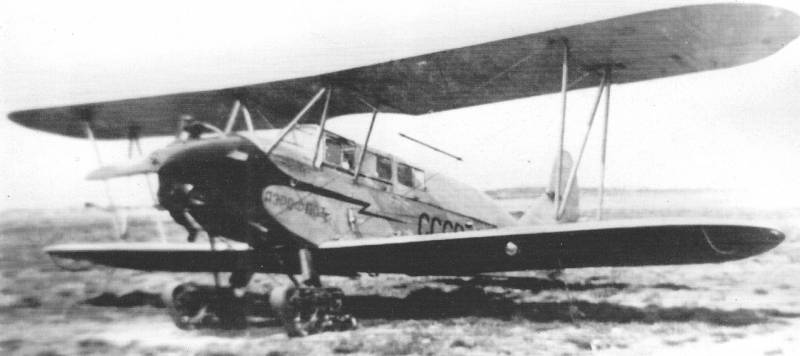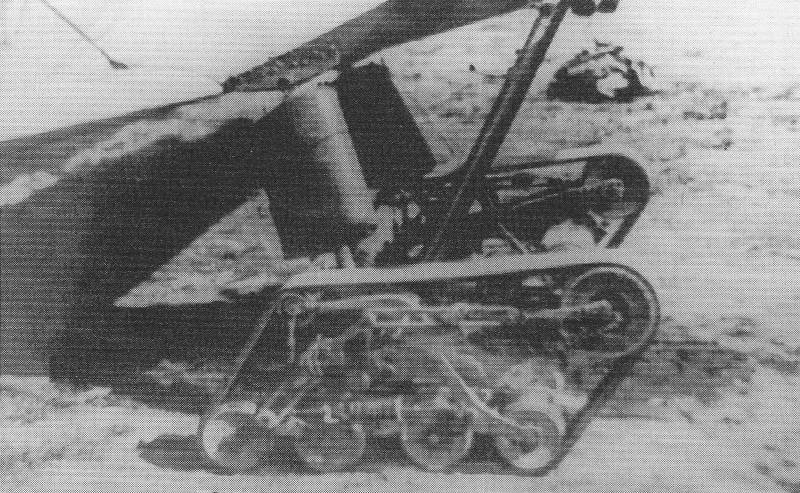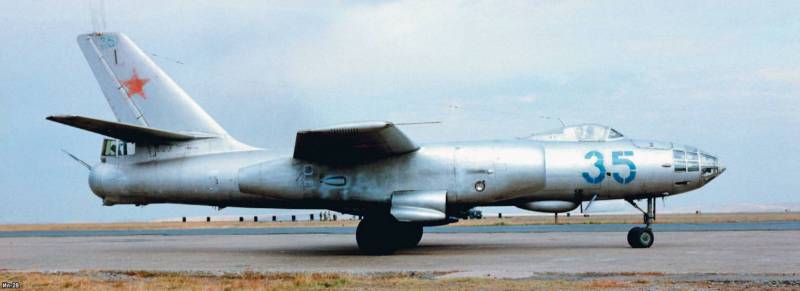Post-war Soviet aircraft tracked landing gear
Recall that in the 1937-43 years, several organizations developed four variants of tracked trucks to equip airplanes of various types. According to one system, it was intended for light aircraft U-2 and Р-5, two more were proposed to be mounted on heavier transport PS-84 / Li-2. The test results of all four systems were similar. Tracked units allowed the aircraft to move through normal airfields, through plowed fields, and even over water-covered marshes, and the aircraft could take off and land on such complex platforms. Aircraft with a regular wheeled chassis did not have such an opportunity.
However, the proposed track systems were too complicated to manufacture, and also did not have high reliability. Thus, the second version of the tracks for Lee-2 did not cope with state tests due to insufficient strength of parts. Even at the ground inspection stage, testers were able to break down both available caterpillars. The result was a refusal to continue work in an interesting direction. However, as further events showed, the refusal was temporary. After the war, work began on new projects.
New Caterpillars for Po-2
The first projects of the tracked chassis for domestic aircraft were created by N.А. Chechubalin or with his participation. The development of a new system like this started on the initiative of his colleague S.A. Bridge. This specialist also worked in the Rationalization and Inventions Bureau of the General Directorate of the Northern Sea Route. For a long time S.A. Mostovoy worked on the development of existing designs and the creation of new products. For example, in 1946, he presented a new design of all-metal floats for the Po-2 aircraft. The following year, he began work on the creation of a promising version of a tracked truck, devoid of the lack of previous designs.
U-2 / Po-2 aircraft trolley, created by N.А. Chechubalin in the late thirties, was a frame with side walls, which was stretched caterpillar specific design. Textolite rods with a diameter of 50 mm and a length of 300 mm were used as tracks. This design solved the tasks, but in the new project it was decided to use other ideas and technical solutions while borrowing some features of the existing development.
The result of S.A. The bridge was a tracked chassis of a relatively complex design with revised and augmented composition of units. To improve the patency, it was decided to use new parts, as well as its own elements of the elastic suspension. Instead of the track, made up of individual links, tracks, now it was necessary to use a solid rubber track. Such a change in the architecture of the trolley allowed us to count on an increase in the softness of the stroke and an improvement in the operational characteristics.
Assembling a new trolley was a relatively complex product of a diamond shape. In its composition there were several rollers and rollers, with the help of which the required shape of the caterpillar was formed with the raised front part and the inclined rear. As before, the front lifting of the track was intended to increase the maneuverability due to the possibility of entering some obstacles. Also, the sprung rollers were responsible for overcoming the obstacles.
The main element of the design of the cart design S.A. The bridge was a longitudinal beam of a curved shape, which had fastenings for several parts and chassis mounts. The front shoulder of the beam-lever had a greater length, at its end there was an axis for the front guide wheel. The back shoulder was shorter and was located at an angle to the front, being tilted down. On this shoulder was the axis of the installation of one of the carts. In the middle part of the beam, at the junction of the shoulders, there was a hinge for installation on the axle of the landing gear wheels of the Po-2 aircraft.
As part of a new type of trolley there were four track rollers. They were interlocked in pairs, and their balancers were connected to the main beam using a set of hinges and additional levers. The rear track roller also served as a stern guide wheel. At the level of the gap between the third and fourth roller was the upper support roller, giving the rubber caterpillar the desired shape. At the respective mounts balancers, levers and beams fastened a set of springs required for depreciation.
S.A. Mostovoi used the already tested approach to ensuring compatibility of the new chassis with existing aircraft. On-2 all modifications were equipped with an extremely simple three-point chassis with a tail crutch. Under the center section was a pair of rigid struts and two similar parts with shock absorbers based on rubber elastic elements. Four of these racks were connected to the horizontal axis on which the wheels were placed. The main landing gear additionally strengthened wire braces. In the framework of the new project, as before, it was proposed to remove regular wheels from the aircraft and put in their place one carriage with a caterpillar.
Already in 1947, by order of the authors of the project, one of the enterprises of the Soviet defense industry produced the first samples of new type of tracked carts that were to be used in future tests. According to various sources, in the framework of testing, new-type products were installed on several modifications of the Po-2 aircraft. In particular, the photos of the Po-2L machine with a closed cabin, which lost its regular wheels and the design of a pair of tracks of S.A. Bridge. After the corresponding modernization of the serial aircraft was released for testing.
In the course of the checks that took place in the same 1947 year, the characteristic advantages of using tracked chassis were once again confirmed, and again the shortcomings in the form of complexity and high prices were revealed. There is reason to believe that testing the updated chassis design with a relatively complex "chassis" could show an improvement in some characteristics. The appearance of several track rollers with depreciation could have a positive effect on the chassis, softness of the course and other characteristics.
The new project with its positive and negative features was similar to previous developments of a similar purpose. For this reason, one would hardly have expected that the results of the project would be different. Like its predecessors, the tracked chassis designed by S.А. The bridge was different from the traditional wheel more complexity of production and operation. In addition, it had very limited areas of application, because of which the start of mass production and operation of new systems was considered inexpedient.
S.A. Mostovoy was engaged in the development of an improved version of the N. A.A. Chechubalina and received some positive results. At the same time, the project has retained several characteristic problems, which is why it did not receive the expected continuation. Potential customers again did not want to use the original chassis with improved characteristics of terrain.
Caterpillars for IL-28
The project tracked chassis authored by S.А. Mostovoy was not developed, nor was it approved for mass production and operation. The original proposal was again put aside. About unusual chassis remembered in the early fifties. At this time, the Soviet air force mastered a number of the latest models of aviation technology, as well as introducing new ideas and strategies. In the context of the implemented program of modernization of the Air Force, special requirements were placed on the permeability of the equipment being developed.
In 1950, the first domestic front-line bomber equipped with jet engines, IL-28, was adopted by the Soviet Union. Machines of this type were to be operated in the harsh conditions of front-line aerodromes, which led to the appearance of corresponding restrictions on take-off and landing characteristics. To further improve the existing parameters in the 1951, it was proposed to equip an off-road chassis bomber. In the future experiment they decided to use the tracks.
The development of a new chassis design for the IL-28 was entrusted to the design bureau of the plant No. XXUMX (Balashikha). The designers were appointed managers of TM. Bashta and A.P. Golubkov. In accordance with the order of the customer, to develop a project and complete the preliminary tests required before the end of 279 year. After that, an experienced aircraft with a new chassis had to go to state tests.
Unfortunately, the details of the tracked chassis project for the Il-28 bomber have not been preserved. According to various sources, trucks with tracked ribbons were to be mounted on the main landing gear located on the underwing engine nacelles. In the basic configuration of the aircraft, the main rack received one large-diameter wheel. Information about replacing the two small wheels of the nose rack is missing. Perhaps, as in the case of previous projects, only the main racks of the three-point chassis should have been refined.
The design of the tracked trucks for the front bomber is unknown. There is reason to believe that, taking into account the experience of previous projects, a relatively complex system was used using several track rollers and guide wheels. A rubber track was installed on rollers and skating rinks, similar to that used in the project by А.А. Bridge. If certain dimensional restrictions were observed, the tracked trolley could be completely retracted into the existing chassis niche.
According to available data, in 1952, the plant # 279 re-equipped the next production IL-28 aircraft using two new tracked vehicles. Soon passed ground and flight tests. Once again, the advantages of the original chassis of a non-standard design were established. In contrast to the bomber with a wheeled chassis, "tracked" machine without significant problems could move on airfields with soft or sodden ground, snow, etc. At the same time, the chassis was harder and harder.
According to known data, testing and refinement of the promising chassis for IL-28 serial front-line bombers continued for a long time. By the middle of 1954, all the expected results were obtained, showing both advantages and disadvantages of the design. Analysis of the test results led to the appearance of a not very surprising and unexpected solution. In July, the 1954 of the year issued a decree of the Council of Ministers of the USSR, according to which Plant No. 279 was supposed to curtail all work on creating a tracked chassis for the Il-28. Earlier planned start of mass production and the introduction of new products into operation was canceled.
Some sources claim that the only prototype Il-28 bomber with an unusual chassis was later transferred to the Moscow Aviation Institute, where for many years it served as a training tool and helped train new specialists.
***
After the end of the Great Patriotic War, the Soviet aviation industry was able to re-engage in promising projects, the implementation of which was previously impossible for objective reasons. Within a few years, two versions of the tracked undercarriage for existing aircraft in active operation were created. One of the projects was intended to retrofit existing light aircraft, while the other was originally designed to improve the performance of air force equipment.
Projects S.A. Bridge and plant number 279 in a sense, based on previous developments, which appeared in the late thirties and early forties. Ironically, these projects not only became a logical continuation of the previous ones, but also ended in a similar way. Despite all the efforts of designers, the new projects retained all the advantages and disadvantages of the previous ones. Attempts to improve the design did not lead to real changes in the ratio of pros and cons. As a result, the post-war tracked landing gear projects for airplanes also failed to get out of the test stage, remaining in stories domestic aviation as the most interesting, but unpromising developments.
Based on:
http://airwar.ru/
http://ruwings.ru/
http://avia.pro/
Shavrov V.B. The history of aircraft structures in the USSR 1938-1950. 2 edition, revised. M .: "Mashinostroenie", 1988
Yakubovich N.V. Unknown Ilyushin. Triumphs of the domestic aviation industry. M .: Eksmo, Yauza, 2012
- Ryabov Kirill
- Polarpost.ru, Aviadejavu.ru



Information